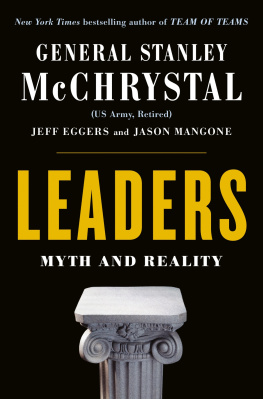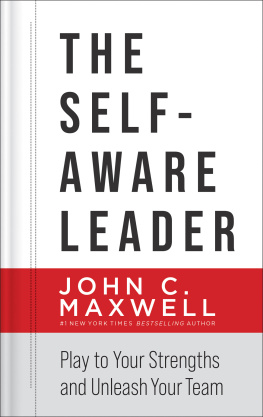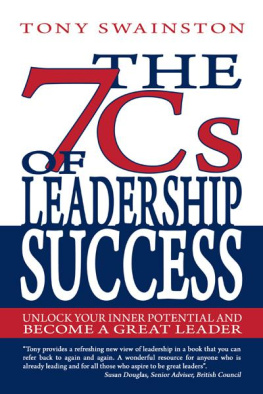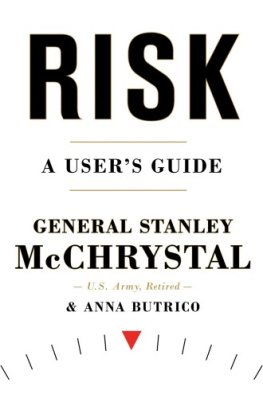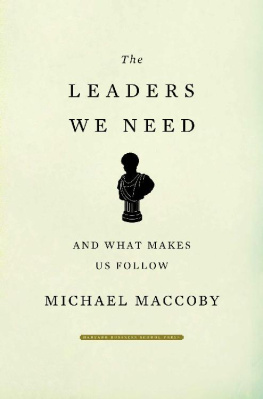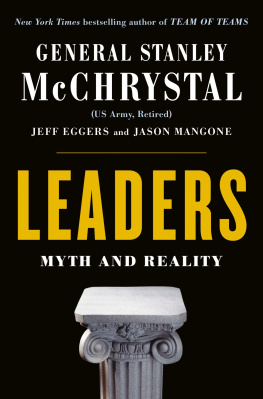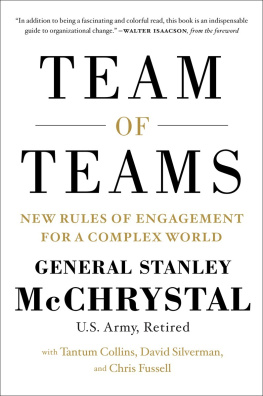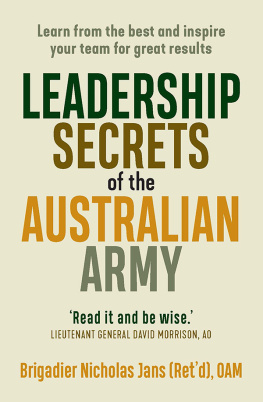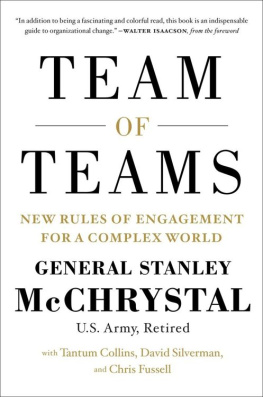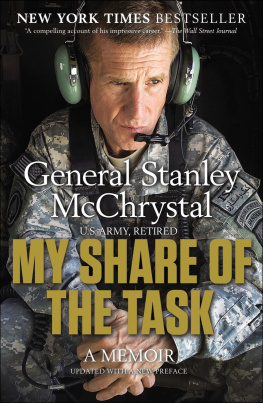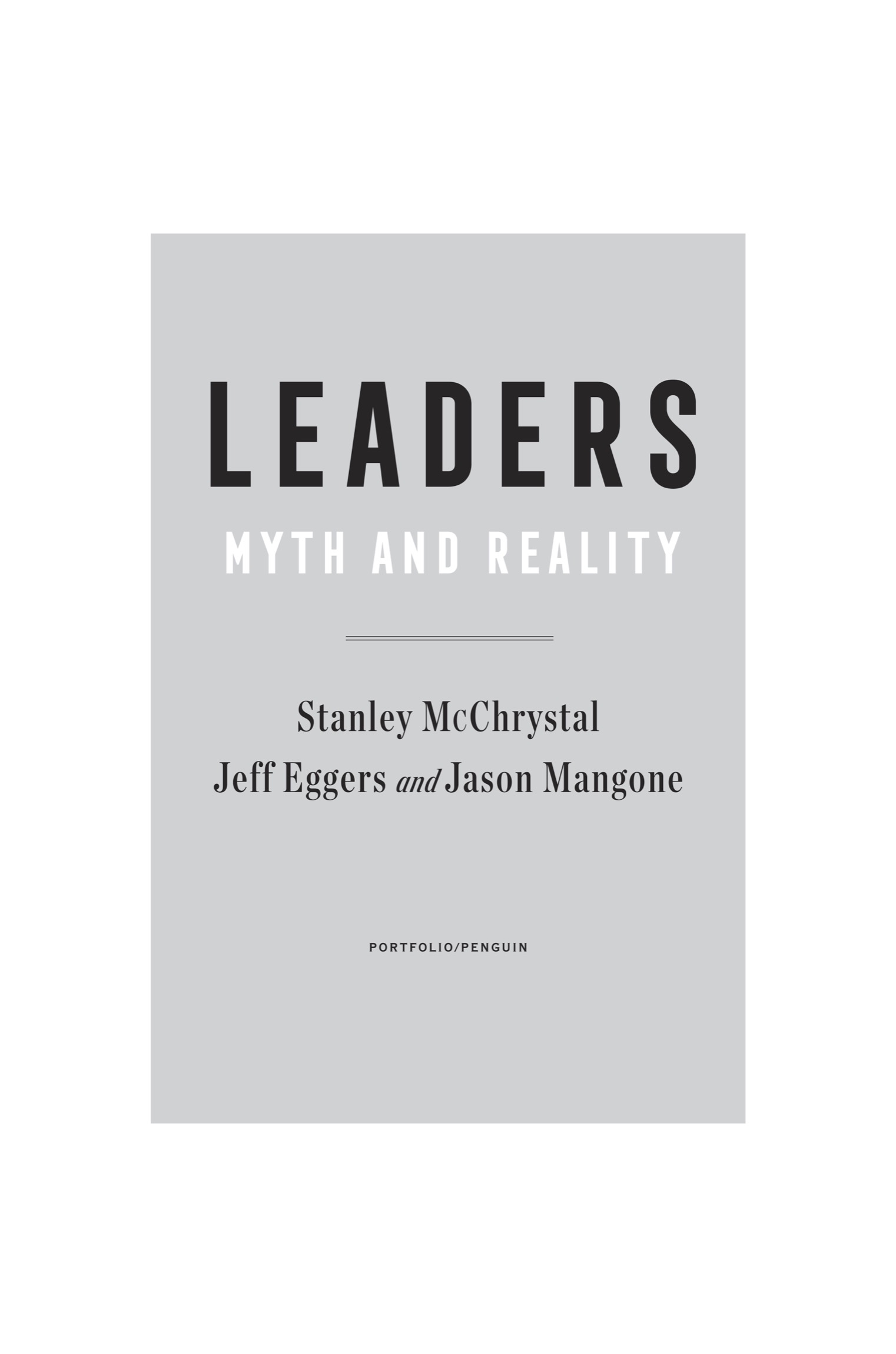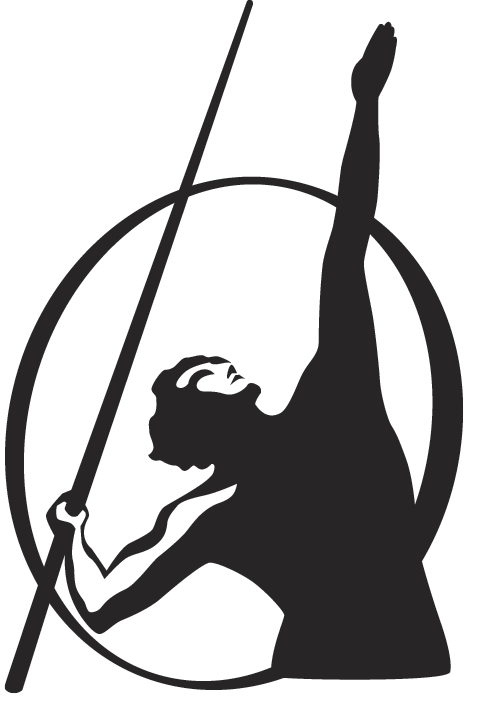
Portfolio/Penguin
An imprint of Penguin Random House LLC
375 Hudson Street
New York, New York 10014

Copyright 2018 by McChrystal Group LLC
Penguin supports copyright. Copyright fuels creativity, encourages diverse voices, promotes free speech, and creates a vibrant culture. Thank you for buying an authorized edition of this book and for complying with copyright laws by not reproducing, scanning, or distributing any part of it in any form without permission. You are supporting writers and allowing Penguin to continue to publish books for every reader.
ISBN: 9780525534372 (hardcover)
ISBN: 9780525534389 (ebook)
While the authors have made every effort to provide accurate telephone numbers, internet addresses, and other contact information at the time of publication, neither the publisher nor the authors assume any responsibility for errors, or for changes that occur after publication. Further, the publisher does not have any control over and does not assume any responsibility for authors or third-party websites or their content.
Version_5
To John Lewis and John McCain, who remind us that its possible to keep our humanity while leading with courage and commitment.
CONTENTS
PROLOGUE
And when our work is done,
Our course on earth is run,
May it be said, Well done
Be thou at peace.
WEST POINTS ALMA MATER
The book is just eight inches tall and fourteen wide, with a fraying orange cloth cover. Some of the pages are torn but after two lifetimes of rough service, it is in remarkably good shape. I should be so lucky.
The tattered childrens book Greek Tales for Tiny Tots was originally purchased in Chattanooga, Tennessee, in 1929 for a young girl named Mary, who treasured it. In the late 1950s Mary, by then my mother, read from it to me. In the 1980s I read it to my son and recently gave my oldest granddaughter, Emmylou, her first look at the worn pages.
The work is special to me. With simply drawn pictures and brief text, it tells stories of Greek and Roman heroes: Theseus, Hercules, Ulysses, Ariadne, and others who struggled against nature, fate, and sometimes each other. It is mythology, but the narratives of individuals whose heroism, vision, or genius, often combined with dogged perseverance, were the dominant force in shaping events resonated deeply with me.
When I could read larger volumes my mother shared Roland, Julius Caesar, William Wallace, and Robin Hood. In my grade school library I found biographies crafted for young readers and remember being caught during arithmetic by my second grade teacher reading a book on John Paul Jones, too intently focused on the story to pretend I was paying attention in class. Later in life, I was given a chess set inscribed with the truism that pawns are the soul of the game. But as a boy, to me history seemed a game in which leaders were kings, queens, bishops, rooks, and knights who stood in sharp contrast in stature, power, and importance to the lowly pawns.
My early lessons in leadership didnt come only from ancient history. My father was a soldier, and I was ten when he deployed on his first tour in Vietnam. Although young, I read to understand the geopolitical labyrinth my father, and my nation, had entered. I came to view the unfolding events primarily as the actions of leaders, political and militarythose who would be successful heroes if the story would cooperate. It did not, but I still believed.
West Point, the familiar name for the United States Military Academy, was founded in 1802 at a scenic bend in the Hudson River. During the Revolutionary War it had been the Continental Armys most strategic post, as it denied British access to the vital waterway north from New York City. In July 1942, my father, himself the son of a career soldier, traveled to West Point to join the Corps of Cadets. Thirty years later, I followed him.
The Academy likes to remind visitors that much of the history we teach was made by leaders we taught, and today it celebrates the role of leadership in Americas past while forging military leaders for her future. West Points mission is, in part, to educate, train, and inspire the Corps of Cadets so that each graduate is a commissioned leader of character.
But it is not the mission statement that dominates the future soldiers experience. From the first day, cadets expectations of leaders, and of themselves, are shaped by the visceral experience of being physically surrounded by reminders of past leaders. Cadets clad in traditional gray move among icons of those who once wore the same uniform. I lived in Pershing Barracks, named for the officer who led Americas Expeditionary Force to France in World War I. When I walked to attend class in Thayer Hall, named for the officer who set the course of West Point in its early years, I passed a bronze George Patton, the aggressive World War II commander. Portraits of famous officers gazed down on every meal, never letting us forget that West Points raison dtre was to mold us into leaders.
At the same time, we were reminded, it was not about us. We were being developed to serve the larger purpose of the nation by extending West Points Long Gray Line, the term used to describe West Points alumni who kept unbroken commitments to the Academy and the nations ideals.
We were taught the beliefs and behaviors of great leaders, not by academics, but largely by young officers recently off the battlefields of Southeast Asia. We inhaled their stories of combat and envied their accomplishments. We admired their integrity, courage, and sense of duty, and we learned to look, walk, and talk in the way they taught us. If we did so, we were told, and believed, we might not be famous leaders, but we would serve well. And we suspected, but never openly speculated, that some of us would make the history future cadets would study.
Soon after graduation it was my turn to lead, first as a Platoon Leaderan infantry lieutenant responsible for twenty 1970s American paratroopers. Although the post-Vietnam Army was a troubled institution, the majority of soldiers, like generations before them, did their jobs with stoic patience. And like leaders of generations before me, I progressed through the ranks to Captain (commanding 150 men), Battalion (commanding 600), and Regiment (about 2,200), before becoming a General Officer.
At that point, my experience took me into territory Id not studied at West Point. In the post9/11 environments of Iraq and Afghanistan I spent almost five years commanding the Joint Special Operations Command, a one-of-a-kind Task Force composed of the nations most elite forces. As an over-fifty-year-old product of earlier-era leadership models, I was challenged by this new environment. I found command on a twenty-first-century, technology-enabled battlefield required not just traditional skills, but also intuitive adaptations.
Throughout my years in military leadership, my reading continued. I had a strong preference for history, frequently reading biographies, like those of George Washington and George Marshall, and the memoirs of Ulysses S. Grant. Novels periodically crept onto my nightstand, although typically they were historically and often militarily grounded. I remember being fascinated by

